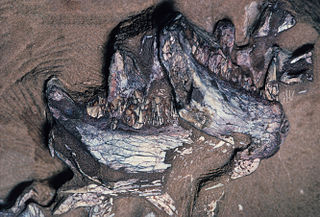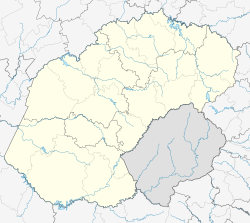
The Free State, formerly known as the Orange Free State, is a province of South Africa. Its capital is Bloemfontein, which is also South Africa's judicial capital. Its historical origins lie in the Boer republic called the Orange Free State and later the Orange Free State Province.

Smithfield is a small town in the Free State province of South Africa. Founded in 1848 in the Orange River Sovereignty, the town is situated in a rural farming district and is the third oldest town in present-day Free State, after Philippolis and Winburg.

Massospondylus was a genus of sauropodomorph dinosaur from the Early Jurassic. It was described by Sir Richard Owen in 1854 from remains discovered in South Africa, and is thus one of the first dinosaurs to have been named. Fossils have since been found at other locations in South Africa, Lesotho, and Zimbabwe. Material from Arizona's Kayenta Formation, India, and Argentina has been assigned to the genus at various times, but the Arizonan and Argentinian material are now assigned to other genera.

The Karoo Supergroup is the most widespread stratigraphic unit in Africa south of the Kalahari Desert. The supergroup consists of a sequence of units, mostly of nonmarine origin, deposited between the Late Carboniferous and Early Jurassic, a period of about 120 million years.

Golden Gate Highlands National Park is located in Free State, South Africa, near the Lesotho border. It covers an area of 340 km2 (130 sq mi). The park's most notable features are its golden, ochre, and orange-hued, deeply eroded sandstone cliffs and outcrops, especially the Brandwag rock. Another feature of the area is the numerous caves and shelters displaying San rock paintings. Wildlife featured at the park includes mongooses, eland, zebras, and over 100 bird species. It is the Free State's only national park and is more famous for the beauty of its landscape than for its wildlife. Numerous palaeontology finds have been made in the park, including dinosaur eggs and skeletons.

Dracovenator is a genus of neotheropod dinosaur that lived approximately 201 to 199 million years ago during the early part of the Jurassic Period in what is now South Africa. Dracovenator was a medium-sized, moderately-built, ground-dwelling, bipedal carnivore, that could grow up to an estimated 5.5–6.5 metres (18–21 ft) in length and 250 kilograms (550 lb) in body mass. Its type specimen was based on only a partial skull that was recovered.

The Clarens Formation is a geological formation found in several localities in Lesotho and in the Free State, KwaZulu-Natal, and Eastern Cape provinces in South Africa. It is the uppermost of the three formations found in the Stormberg Group of the greater Karoo Supergroup rocks and represents the final phase of preserved sedimentation of the Karoo Basin.
The Bushveld Sandstone is a geological formation dating to roughly between 201 and 189 million years ago and covering the Carnian to Norian stages. The Bushveld Sandstone is found in Transvaal, South Africa, and is a member of the Stormberg Group. As its name suggests, it consists mainly of sandstone. Fossils of the prosauropod dinosaur Massospondylus have been recovered from the Bushveld Sandstone.

The Elliot Formation is a geological formation and forms part of the Stormberg Group, the uppermost geological group that comprises the greater Karoo Supergroup. Outcrops of the Elliot Formation have been found in the northern Eastern Cape, southern Free State, and in the eastern KwaZulu-Natal provinces of South Africa. Outcrops and exposures are also found in several localities in Lesotho such as Qacha's Neck, Hill Top, Quthing, and near the capital, Maseru. The Elliot Formation is further divided into the lower (LEF) and upper (UEF) Elliot formations to differentiate significant sedimentological differences between these layers. The LEF is dominantly Late Triassic (Norian-Hettangian) in age while the UEF is mainly Early Jurassic (Sinemurian-Pliensbachian) and is tentatively regarded to preserve a continental record of the Triassic-Jurassic boundary in southern Africa. This geological formation is named after the town of Elliot in the Eastern Cape, and its stratotype locality is located on the Barkly Pass, 9 km north of the town.

The Molteno Formation is a geological formation found in several localities in Lesotho and South Africa. It lies mainly south of Maseru, near Burgersdorp, Aliwal North, Dordrecht, Molteno, and Elliot. It extends as far north as Matatiele in the Eastern Cape. The formation's localities lie along the Drakensberg Mountains in Kwazulu-Natal, and near Ladybrand in the Free State of South Africa. The Molteno Formation is the lowermost of the three formations in the Stormberg Group of the greater Karoo Supergroup. The Molteno Formation represents the initial phase of preserved sedimentation of the Stormberg Group.
Ignavusaurus is a genus of basal sauropodomorph dinosaur that lived during the Early Jurassic in what is now Lesotho. Its fossils were found in the Upper Elliot Formation which is probably Hettangian in age. It was described on the basis of a partial, well preserved articulated skeleton. The type species, I. rachelis, was described in 2010 by Spanish palaeontologist F. Knoll.

The Stormberg Group is one of the four geological groups that comprises the Karoo Supergroup in South Africa. It is the uppermost geological group representing the final phase of preserved sedimentation of the Karoo Basin. The Stormberg Group rocks are considered to range between Lower Triassic (Olenekian) to Lower Jurassic (Pliensbachian) in age. These estimates are based on means of geological dating including stratigraphic position, lithostratigraphic and biostratigraphic correlations, and palynological analyses.

Maluti-a-Phofung Municipality is a local municipality within the Thabo Mofutsanyane District Municipality, in the Free State province of South Africa. It encompasses substantially all of the former bantustan of QwaQwa, except for the small enclave at Botshabelo. The population is almost entirely Basotho. The municipality is named after the Drakensberg mountains. The peak is known as the Sentinel, which is called Phofung in Sesotho.

Pegomastax is a genus of heterodontosaurid dinosaur that lived during the Early Jurassic of South Africa. The only known specimen was discovered in a 1966-1967 expedition in Transkei District of Cape Province, but wasn't described until 2012 when Paul Sereno named it as the new taxon Pegomastax africana. The genus name is derived from the Greek for "strong jaw", and the species name describes the provenance of Africa; it was originally spelled africanus, was corrected to africana to align with the gender of the genus name.

Megapnosaurus is an extinct genus of coelophysid theropod dinosaur that lived approximately 188 million years ago during the early part of the Jurassic Period in what is now Africa. The species was a small to medium-sized, lightly built, ground-dwelling, bipedal carnivore, that could grow up to 2.2 m (7.2 ft) long and weigh up to 13 kg (29 lb). It was originally given the genus name Syntarsus, but that name was later determined to be preoccupied by a beetle. The species was subsequently given a new genus name, Megapnosaurus, by Ivie, Ślipiński & Węgrzynowicz in 2001. Some studies have classified it as a species within the genus Coelophysis, but this interpretation has been challenged by more subsequent studies and the genus Megapnosaurus is now considered valid.
For thousands of years, a pilgrimage has been made by the Basotho people to a network of sacred caves to communicate with the spiritual world. The caves also contain dinosaur footprints and ancient rock paintings. The caves are located between the eastern parts of the Free State and Lesotho. These sacred caves are often described as 'the key to religion' in Southern Africa.
The Battle of Naauwpoort Nek refers to a clash between the Trekboers and Basotho warriors on 29 September 1865. Naauwpoort lies immediately to the north of the Free State town of Clarens.
The geology of Lesotho is built on ancient crystalline basement rock up to 3.6 billion years old, belonging to the Kaapvaal Craton, a section of stable primordial crust. Most of the rocks in the country are sedimentary or volcanic units, belonging to the Karoo Supergroup. The country is notable for large fossil deposits and intense erosion due to high rainfall and a rare case of southern African glaciation during the last ice age. Lesotho has extensive diamonds and other natural resources and has the highest concentration of kimberlite pipes anywhere in the world.

Lessemsauridae is a clade of early sauropodiform dinosaurs that lived in the Triassic and Jurassic of Argentina, South Africa and possibly Lesotho. A phylogenetic analysis performed by Apaldetti and colleagues in 2018 recovered a new clade of sauropodiforms uniting Lessemsaurus, Antetonitrus, and Ingentia which they named Lessemsauridae. It is a node-based taxon, defined as all descendants of the most recent common ancestor of Lessemsaurus sauropoides and Antetonitrus ingenipes. Depending on the definition of Sauropoda, Lessemsauridae is either one of the most basal sauropod taxa, or a sister taxon of Sauropoda. An additional member of the clade was named later in 2018, Ledumahadi. A 2021 study by Pol and colleagues also assigned the genera Kholumolumo and Meroktenos to the group.

Ngwevu is a genus of massospondylid sauropodomorph dinosaur from the Lower Jurassic of South Africa. The genus contains one species, Ngwevu intloko.

























